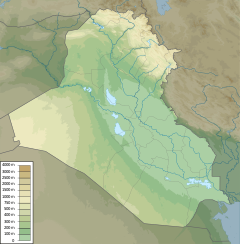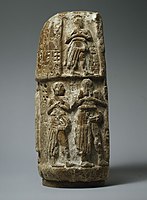Stele of Ushumgal
| Stele of Ushumgal | |
|---|---|
 | |
| Material | Gypsum alabaster |
| Size | 22 cm high |
| Created | circa 2900-2700 BCE |
| Discovered | Possibly Umma 31°37′17″N 45°56′00″E / 31.621369°N 45.933406°E |
| Present location | British Museum, London |
| Registration | Metropolitan Museum of Art 58.29 |
The Stele of Ushumgal is an early Sumerian stone tablet, dating to the Early Dynastic I-II (circa 2900-2700 BCE), and probably originating from Umma.[3][4] It is currently located in the Metropolitan Museum of Art, New York.[3][1][5]
The stele is 22 cm high. It is partially deciphered, refers to an early transfer of land ownership. A large man is inscribed with a label, which can be read “Ušumgal, the pab-šeš priest of (the deity) Šara”. On the other side stands Shara-igizi-Abzu, the daughter of Ushumgal.[3][1][6]
The stele has been described as a type of "ancient Kudurru", a sort of stele known from the Kassites period in the 2nd millennium BCE.[7][8]
The name "Akka" appears in the Stele of Ushumgal, as Ak gal-ukkin, "Ak gal-ukkin official". It has been suggested this could refer to Aga of Kish himself.[9][10]
-
The daughter of Ushumgal.
-
Three men, possibly from a local council
-
The name "Akka" appears in the Stele of Ushumgal, as Ak gal-ukkin, "Ak gal-ukkin official". It has been suggested this could refer to King Aga of Kish himself.[9][11]
-
Another figure
-
Line art of Aga of Kish from the Stele of Ushumgal.
See also
[edit]References
[edit]- ^ a b c "Stele of Ushumgal". www.metmuseum.org.
- ^ Art of the First Cities: The Third Millennium B.C. from the Mediterranean to the Indus. Metropolitan Museum of Art. 2003. p. 53. ISBN 978-1-58839-043-1.
- ^ a b c "Ushumgal Stele CDLI". cdli.ox.ac.uk.
- ^ "Metropolitan Museum of Art". www.metmuseum.org.
- ^ Balke, Thomas E.. "The Interplay of Material, Text, and Iconography in Some of the Oldest “Legal” Documents". Materiality of Writing in Early Mesopotamia, edited by Thomas E. Balke and Christina Tsouparopoulou, Berlin, Boston: De Gruyter, 2016, pp. 73-94
- ^ [1]Durgun, Pınar, "Enheduanna and Her World: Individual Women in Ancient Western Asia", pp. 279-286, 2024
- ^ I. J. Gelb, P. Steinkeller, and R. M. Whiting Jr, "OIP 104. Earliest Land Tenure Systems in the Near East: Ancient Kudurrus", Oriental Institute Publications 104 Chicago: The Oriental Institute, 1989, 1991 ISBN 978-0-91-898656-6 Text Plates
- ^ Beaulieu, Paul-Alain (2018). A History of Babylon, 2200 BC - AD 75. John Wiley & Sons. p. 35. ISBN 978-1-4051-8898-2.
- ^ a b Frayne, Douglas. The Struggle for Hegemony in "Early Dynastic II" Sumer. pp. 65–66.
- ^ "CDLI-Found Texts". cdli.ucla.edu.
- ^ "CDLI-Found Texts". cdli.ucla.edu.
Further reading=
[edit]- Wilcke, Claus, "Zur Ušumgal-Stele: ELTS 12", The Third Millennium. Brill, pp. 716-729, 2020
External links
[edit]Text is available under the CC BY-SA 4.0 license; additional terms may apply.
Images, videos and audio are available under their respective licenses.





![The name "Akka" appears in the Stele of Ushumgal, as Ak gal-ukkin, "Ak gal-ukkin official". It has been suggested this could refer to King Aga of Kish himself.[9][11]](https://upload.wikimedia.org/wikipedia/commons/thumb/7/7f/Ak_gal-ukkin.jpg/200px-Ak_gal-ukkin.jpg)


